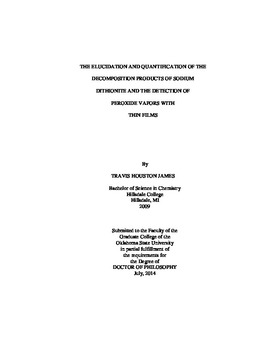| dc.contributor.advisor | Materer, Nicholas F. | |
| dc.contributor.author | James, Travis Houston | |
| dc.date.accessioned | 2015-06-17T20:06:24Z | |
| dc.date.available | 2015-06-17T20:06:24Z | |
| dc.date.issued | 2014-07 | |
| dc.identifier.uri | https://hdl.handle.net/11244/14904 | |
| dc.description.abstract | Sodium dithionite (Na2S2O4) is an oxidizable sulfur oxyanion often employed as a reducing agent in environmental and synthetic chemistry. When exposed to the atmosphere, dithionite degrades through a series of decomposition reactions to form a number of compounds, with the primary two being bisulfite (HSO32-) and thiosulfate (S2O32-). Ten samples of sodium dithionite ranging from brand new to nearly fifty years old were analyzed using ion chromatography; from this, a new quantification method for dithionite and thiosulfate was achieved and statistically validated against the current three iodometric titration method used industrially. Additional sample analysis with Raman spectroscopy of solid and dissolved samples identified unique compounds in the oldest samples, including dithionate (S2O62-) and tetrathionate (S4O62-). | |
| dc.description.abstract | Additionally, titania nanoparticles in a hydroxypropyl cellulose matrix were used to prepare films on polycarbonate slides and coatings on cellulose papers. The exposure of these materials to hydrogen peroxide gas led to the development of an intense yellow color. Using an inexpensive web camera and a tungsten lamp to measure the reflected light, first-order behavior in the color change was observed when exposed to peroxide vapor of less than 50 ppm. For 50 mass percent titania nanoparticles in hydroxypropyl cellulose films on polycarbonate, the detection limit was estimated to be 90 ppm after a 1-minute measurement and 1.5 ppm after a 1-hour integration. The coatings on the filter paper had a threefold higher sensitivity compared to the films, with a detection limit of 5.4 ppm peroxide for a 1-minute measurement and 0.09 ppm peroxide for a 1-hour integration period. Further experimentation with the effects of acid loading on the filter paper coatings identified these as possible sensors for organic peroxides. With the addition of sulfuric acid, the support was changed from cellulose to glass microfiber or silica. This coatings showing increased sensitivity when compared to coatings with hydrochloric acid. Finally, coatings containing an ionic liquid solvent and trifluoromethanesulfonic acid were produced and found to have increased longevity. These coatings have potential as peroxide vapor sensors for both industrial and security applications. | |
| dc.format | application/pdf | |
| dc.language | en_US | |
| dc.rights | Copyright is held by the author who has granted the Oklahoma State University Library the non-exclusive right to share this material in its institutional repository. Contact Digital Library Services at lib-dls@okstate.edu or 405-744-9161 for the permission policy on the use, reproduction or distribution of this material. | |
| dc.title | Elucidation and quantification of the decomposition products of sodium dithionite and the detection of peroxide vapors with thin films | |
| dc.contributor.committeeMember | Apblett, Allen | |
| dc.contributor.committeeMember | Blum, Frank | |
| dc.contributor.committeeMember | Bunce, Richard | |
| dc.contributor.committeeMember | El Rassi, Ziad | |
| dc.contributor.committeeMember | Ley, Tyler | |
| osu.filename | James_okstate_0664D_13483.pdf | |
| osu.accesstype | Open Access | |
| dc.type.genre | Dissertation | |
| dc.type.material | Text | |
| thesis.degree.discipline | Chemistry | |
| thesis.degree.grantor | Oklahoma State University | |
